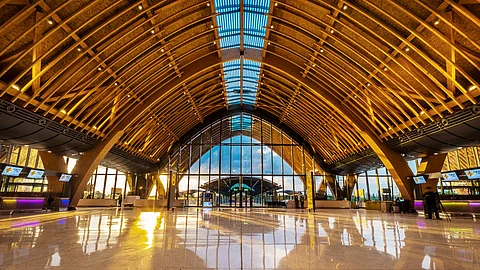
- NEWS
- the EDIT
- COMMENTARY
- BUSINESS
- LIFE
- SHOW
- ACTION
- GLOBAL GOALS
- SNAPS
- DYARYO TIRADA
- MORE

Six thousand solar panels dot the rooftop of the Mactan Cebu International Airport’s (MCIA) Terminal 1 building. The mini power plant’s capacity of 1.64 megawatt peak (MWp), the maximum power output of a solar photovoltaic system under ideal conditions, offsets the equivalent of 1.3 million kilograms of carbon dioxide each year. It also saves on electricity cost.
Nevertheless, the Mactan Electric Company still provides most of the power needs of the airport’s two terminals, according to Engr. Achilles Ponce, the chief of the MCIA Authority’s Engineering Department. The MCIA Authority also has backup power generators for Terminals 1 and 2 in case of an outage, while its primary substation supplies electricity to its corporate building and sewage treatment plant.
Installed in 2017, the rooftop solar power plant is getting an upgrade.
“We are also looking at expanding the installed capacity to further support our sustainability journey — but we don’t have specific details yet on the expansion since we’re still at the planning stage,” reveals Dee Verano, head of the Corporate and Media Affairs of Aboitiz Infra Capital GMCAC which manages and operates the MCIA.
The move is in line with the airport’s campaign of achieving its Net Zero emissions target by 2050.
“Achieving Net Zero emissions is not just about reducing our carbon footprint; it’s about ensuring that our impact on the environment is effectively neutralized, leaving a sustainable legacy for future generations,” says Athanasios Titonis, Aboitiz InfraCapital MCIA President and chief executive officer.
Aside from the rooftop solar power plant, energy-efficient equipment are being used at the airport, such as LED lights.
Meanwhile, MCIA’s landmark Level I Airport Carbon Accreditation from the Airports Council International, the first for an international airport in the Philippines, reflects MCIA’s comprehensive approach to carbon management and highlights the proactive steps taken to reduce its carbon emissions.
“It validates our efforts to minimize our carbon footprint and sets a model for airports in the country and even across the region to follow,” Titonis says.
MCIA developed a Carbon Footprint Report covering 2022 data, a key component of the ACA. By setting operational boundaries, Scope 1 and Scope 2 emissions from MCIA Authority and Aboitiz InfraCapital GMCAC were identified and quantified to determine the total carbon emissions generated by MCIA operations.
Furthermore, MCIA Authority CEO and general manager Julius G. Neri Jr. released a Policy Commitment to Emissions Reduction, a public written commitment to greenhouse gas, carbon or energy reduction at the highest level.
With its strategic location and world-class facilities, MCIA aims to establish itself as the leading tourism gateway of the country with exceptional travel experience, connecting the world to the Philippines.
